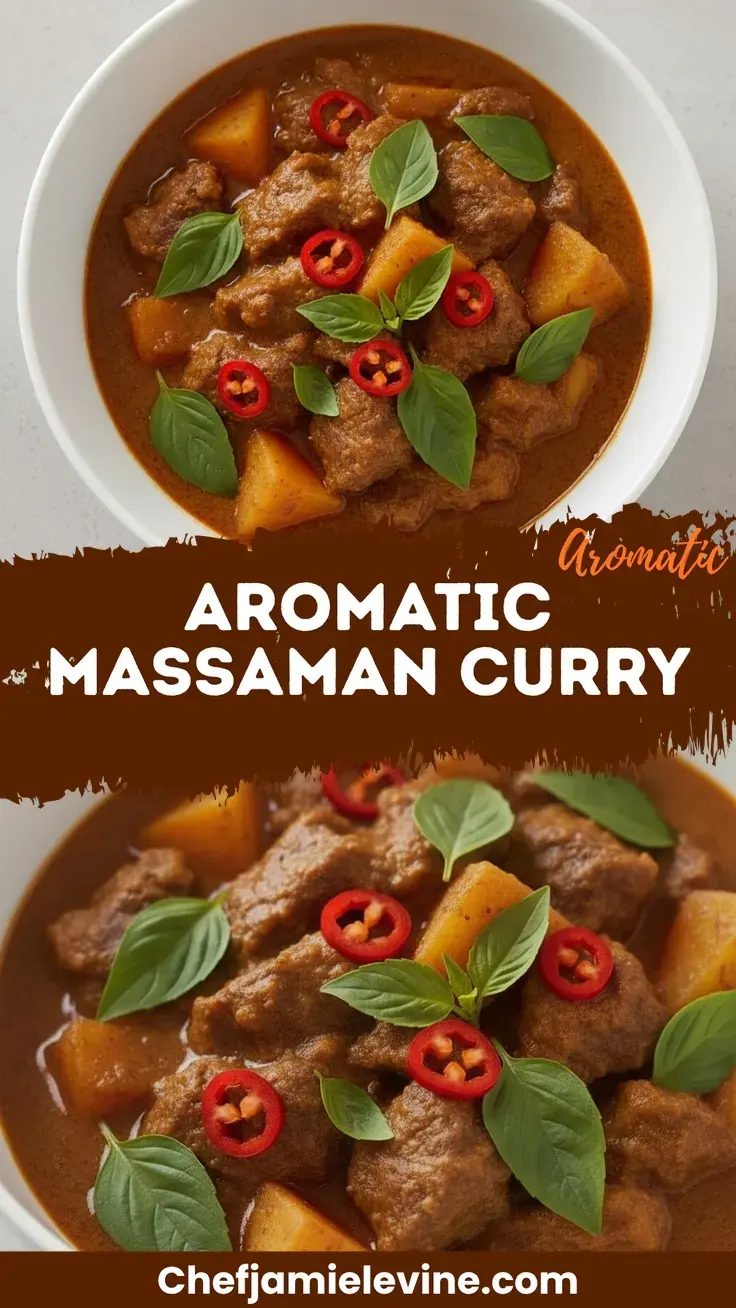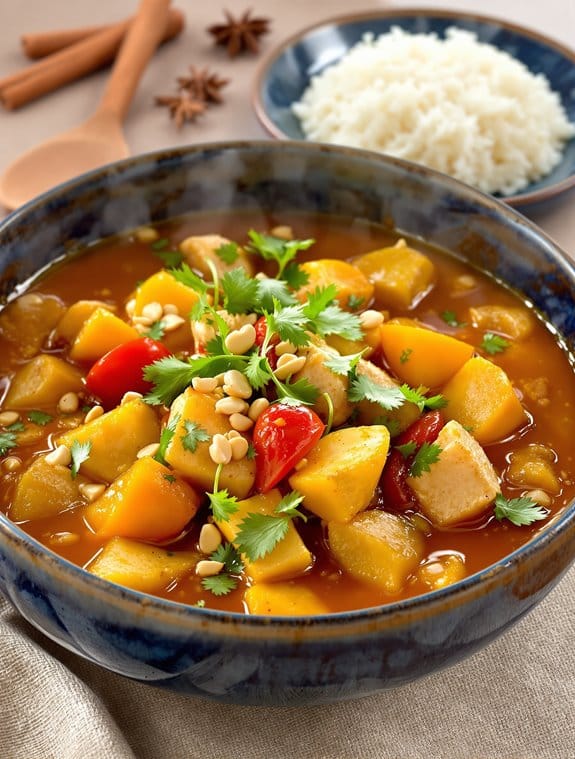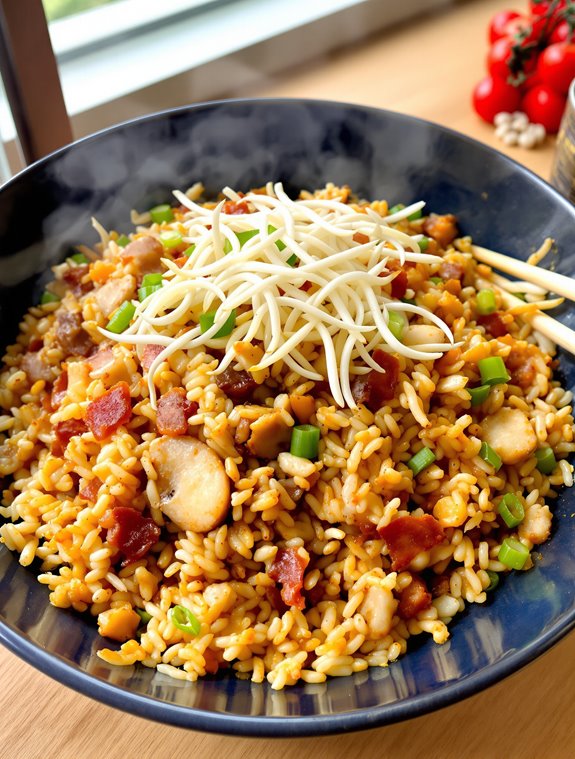Why You’ll Love this Aromatic Massaman Curry
With its rich blend of aromatic spices and creamy coconut milk, this Massaman curry will transport your taste buds straight to Thailand.
I’m obsessed with how the Chinese five-spice, cumin, and turmeric create layers of warmth without overwhelming heat.
What makes this curry special? The perfect balance of textures—tender chicken, soft potatoes, and crunchy peanuts swimming in that velvety sauce.
You’ll appreciate how everything cooks in one pot, too.
No fussy techniques or hard-to-find ingredients here. Just honest comfort food that’s fancy enough for guests but simple enough for a Tuesday night when you’re craving something more exciting than pasta.
What Ingredients are in Aromatic Massaman Curry?
This aromatic Massaman curry brings together a beautiful blend of Thai and Indian influences with its warm spices, creamy coconut milk, and satisfying protein. The ingredient list might look a bit long at first glance, but don’t let that intimidate you—most are pantry staples or easily found at your local grocery store. And trust me, the flavor payoff is absolutely worth gathering these ingredients.
- 1 tablespoon cooking oil
- 1 onion, chopped
- 2 garlic cloves, minced
- 1 teaspoon fresh ginger, chopped
- 1 teaspoon Chinese five spice powder
- 1 teaspoon ground cumin
- 1/4 teaspoon cayenne
- 1/4 teaspoon turmeric
- 1 teaspoon salt
- 1 cup low sodium chicken broth
- 1/2 cup canned unsweetened coconut milk (or heavy cream as an alternative)
- 1/2 pound boiling potatoes, peeled and cut into 1/2-inch pieces
- 1 1/3 pounds boneless skinless chicken breasts, cut into 1/2-inch pieces
- 1/2 cup peanuts, chopped
- 1/2 pound plum tomatoes, cut into wedges
- 3 tablespoons cilantro, chopped
When shopping for these ingredients, quality matters for a few key items. Try to find full-fat coconut milk for the richest flavor—the light versions just don’t create that same silky texture.
For the chicken, thighs can be substituted if you prefer darker meat with more moisture. And while the recipe calls for peanuts, cashews can work wonderfully if you have a peanut allergy or simply prefer their milder flavor profile.
The spices should be as fresh as possible to really make those aromatic notes sing.
How to Make this Aromatic Massaman Curry

Starting this curry is like building layers of flavor, one aromatic spoonful at a time.
Begin by heating 1 tablespoon of cooking oil in a large saucepan over medium-low heat. Add your chopped onion and let it cook gently until translucent, about 5 minutes—this slow cooking develops sweetness without any browning.
Next comes the aromatic powerhouse: 2 minced garlic cloves and 1 teaspoon fresh chopped ginger, followed immediately by the spice blend. Add 1 teaspoon Chinese five spice powder, 1 teaspoon ground cumin, 1/4 teaspoon cayenne, 1/4 teaspoon turmeric, and half of your salt (that’s 1/2 teaspoon). Let these spices bloom in the oil for about a minute, until your kitchen fills with the most incredible fragrance.
Now for the liquid elements that transform these aromatics into a proper curry. Whisk in 1 cup of low-sodium chicken broth, followed by 1/2 cup of unsweetened coconut milk, bringing everything to a gentle simmer. This is when the magic really starts to happen.
Add 1/2 pound of peeled and cubed potatoes, cover the pot, and let them cook until almost tender, about 12 minutes. The potatoes will absorb all those wonderful spices while cooking. Once they’re nearly done, it’s time for the protein—add 1 1/3 pounds of chicken breast pieces to the simmering sauce, cover again, and cook for 5 more minutes.
The final touch brings texture and freshness to balance the rich curry base. Stir in 1/2 cup chopped peanuts for crunch, 1/2 pound of plum tomato wedges for brightness, 3 tablespoons of chopped cilantro for herbal notes, and the remaining 1/2 teaspoon of salt to perfect the seasoning.
Now comes the clever part—turn off the heat completely, but keep the pot covered. This gentle resting period allows the chicken to finish cooking in the residual heat without becoming tough, just about 2 minutes more.
The result? Tender chicken in a complex, aromatic sauce that tastes like it simmered for hours, not minutes. Serve with steamed white rice to soak up every last drop of that magnificent curry.
Aromatic Massaman Curry Substitutions and Variations
While traditional Massaman curry offers delicious authentic flavors, several substitutions can transform this dish to suit your pantry or dietary needs.
Can’t find five-spice powder? A blend of cinnamon, star anise, and cloves works wonderfully.
Vegetarians might swap chicken for firm tofu or chickpeas, with vegetable broth instead of chicken stock.
No coconut milk? Heavy cream makes a rich (though less authentic) alternative.
Sweet potatoes can replace regular potatoes for a nutritional boost, and cashews work nicely when peanuts aren’t available.
I sometimes add butternut squash or a handful of spinach for extra vegetables—trust me, they melt beautifully into the aromatic sauce.
What to Serve with Aromatic Massaman Curry
Now that you’ve mastered the curry itself, let’s talk about what to pair with your aromatic Massaman masterpiece.
Steamed white rice is the classic choice, and frankly, I can’t imagine a better canvas for soaking up all that rich, peanutty sauce. The fluffy grains catch every drop of goodness.
For drinks, I love a crisp chenin blanc or sauvignon blanc—something with enough personality to stand up to the curry’s bold flavors.
New Zealand sauvignons work brilliantly here. Trust me, the right wine transforms this meal from delicious to absolutely memorable.
Final Thoughts
After trying this aromatic Massaman curry, you’ll understand why it remains one of Thailand’s most beloved dishes worldwide.
I’ve served this countless times, always to rave reviews and empty plates. The blend of warm spices, creamy coconut milk, and crunchy peanuts creates a complexity that’s both comforting and sophisticated.
What I love most? How adaptable it is.
Got vegetarians coming? Swap in tofu and vegetable broth. Need a make-ahead meal? This curry actually tastes better the next day as the flavors meld together.
Trust me, this recipe might just become your new go-to comfort food.

Massaman Curry
Ingredients
Equipment
Method
- Heat cooking oil in a large saucepan over medium-low heat. Add onion and cook until translucent, about 5 minutes.
- Add minced garlic and chopped ginger, then immediately incorporate the spice mixture: Chinese five spice powder, ground cumin, cayenne, turmeric, and half of the salt (1/2 teaspoon). Allow spices to bloom in the oil for about 1 minute until fragrant.
- Whisk in chicken broth followed by coconut milk, bringing the mixture to a gentle simmer.
- Add potato cubes, cover the pot, and simmer until potatoes are almost tender, about 12 minutes.
- Add chicken pieces to the simmering sauce, cover again, and cook for 5 more minutes.
- Stir in chopped peanuts, tomato wedges, chopped cilantro, and the remaining 1/2 teaspoon of salt.
- Turn off the heat but keep the pot covered. Allow the curry to rest for about 2 minutes, letting the chicken finish cooking in the residual heat.
- Serve hot with steamed white rice.



